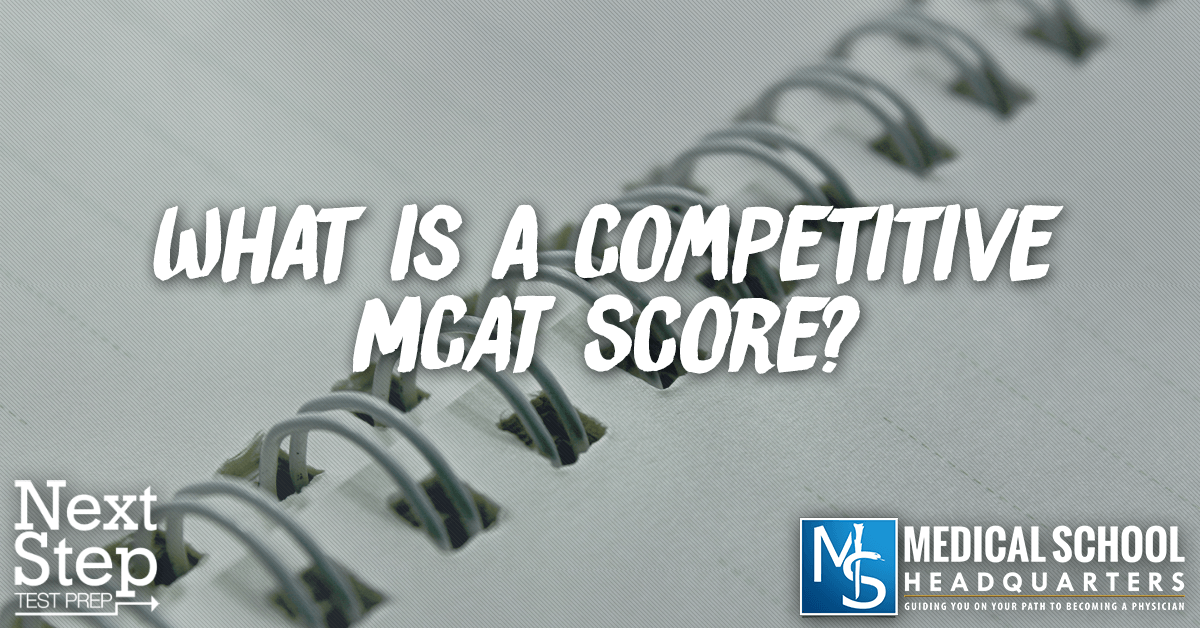You still have time to sign up with one of our amazing expert advisors! Learn More!
Apple Podcasts | Google Podcasts

When studying for the MCAT and taking practice tests, it can be helpful to have a goal score you’re aiming at. But you might not be sure which score you need to get into a medical school on your list.
So, what is a good MCAT score? A good MCAT score is around 511 or higher, since that is the average MCAT score of successful matriculants. Keep in mind that many students get accepted to medical school with lower MCAT scores, too. But 511+ is considered competitive.
In this episode, we’ll talk all about how to view your MCAT score and what you should be aiming for! Listen with the podcast player above, or keep reading for the takeaway points!
You don't need a 520+ MCAT score to become a doctor.Click To TweetThis podcast episode was recorded in 2017, so some of the AAMC data we referenced is out-of-date. In this episode, we refer to a 508 as a competitive MCAT score, but now 511 is the number to shoot for if you want to meet the average for accepted students. Here is the updated AAMC data.
The AAMC has provided data from the 2016-2017 application cycle where they give you a grid of GPA crossed with MCAT score and the acceptance rate, how many people applied with these numbers, and how many people were accepted with these numbers.
When you think about the odds of getting in and how that relates to an MCAT score, this is how to think of it: Either my MCAT score hurts my application, my MCAT score is neutral on my application, my MCAT score is good enough but nothing special, or my MCAT score helps in my application.
For many students, a good score is just a score that doesn’t hurt them. For the overachievers, a good score is something that specifically helps their application.
Looking at the AAMC chart, the very bottom right shows all the applicants in the country (27, 772) and all the accepted students in the country (8,883) with an overall acceptance rate of 32%.
The average applicant's chances of getting into med school are 32%. This is where you start.Click To TweetThis is a tough starting point because it could mean a 2/3 chance of failure. But this is the starting position for considering what helps and what hurts.
And this statement should be qualified: There are a lot of students that simply shouldn’t be applying—like anybody below a 3.0 GPA—and their low acceptance rates are pulling this statistic down. If you remove those applicants from the equation, then the acceptance rate shoots up significantly.
[Related post: MCAT Scores: What Do I Need?]
The nationwide average MCAT score for people who got accepted into allopathic (MD) programs in the US was about 509. Ever since the switch to the new MCAT in 2015, the mantra at Blueprint MCAT (formerly Next Step Test Prep) has been “508 is the new 30.” (30 was often cited as the score to shoot for on the old MCAT.)
Next Step was telling everybody that an MCAT score of 508 511 is the new number to shoot for. This was based on percentiles, considering that the MCAT has always been competitive and that it has always demanded that you be about among the top 20% in the nation. A 508 511 was just about the 80th percentile, so this is the score to shoot for.
The bottom line: If you get a 511, that’s going to help your application because it puts you in the “average student who gets accepted” group and not just in the “average applicant” group.
Anything below a 508 is going to hurt you. That’s not to say you can’t get in with a lower score like a 505. You absolutely can if the rest of your application is strong. But it’s going to be a weak spot in your application.
508-510 are all fine, and if you don’t get accepted with a score in that range, it’s not because of your MCAT score. Anything that’s 510 and above will help you.
This is going to discourage a lot of people because they may only be getting a 504 or 505. But there is a huge difference between what is a competitive score and what is a score that will get your application a look and possibly get you an interview.
I’ve worked with plenty of students that are getting 501, 502, or 503, and they’re still getting interviews and acceptances. So the difference between competitive and good enough is huge, and it all depends on your complete application.
A lot of students focus on the MCAT, thinking it’s all they need to get into school. Looking at this table, more than 10% of students who had more than 3.79 GPA and greater than a 517 on the MCAT still couldn’t get into medical school. So a good MCAT score is not the only factor.
Update: In episode 335 of The Premed Years, I interviewed Austin, who got into medical school with a 496 on the MCAT. Listen to see how he did it!
Scoring over 517 on the MCAT is the top 5% in the nation, but still, 12.5% of those people managed to screw up the interviews so badly they didn’t get in, or they wrote poor personal statements or had poor letters of recommendations.
Usually, the people getting these high MCAT scores are possibly not the most social people, and they may not have great communication skills; so you need to have a well-rounded application. It’s not just your MCAT score or your GPA. It’s so much more than that.
So, for students who are doing about average or a little above average on the MCAT, in the 502-505 range, that’s good enough to get a look and probably good enough to get an interview—although you would have to knock it out of the park on everything else—it could get you an acceptance.
Then when you get to the 506-509 range, there’s a significant jump in the acceptance rate at 46.2%. So, now you’re well above the national average for MCAT scores, and that’s likely to be accepted.
And then there’s an enormous jump once you get to the 510-513 mark at 60.3%. And then the acceptance rates for people scoring the highest on the MCAT reaches up to almost 80%.
Once you hit 510 MCAT score, it becomes a real asset on your application.Click To TweetNevertheless, there is a compounding effect: the kind of student who is with it enough to really work hard and get a 516 MCAT score (for example), is probably also getting their clinical exposure, their lab work, and all the other things they’re supposed to be doing, as well.
Unless you’re trying to come work for him and become a premium MCAT tutor, there is literally no reason to go for a 520.
Your GPA and the MCAT score only really serve two functions. First is to make sure they don’t throw out your application. They have to be good enough so they will look at you as a human being.
Second, they have to be good enough that they will interview you because no medical school in the country takes someone without interviewing them first.
If you got a 510, they’re certainly going to interview you as long as everything else is fine. We’ve never heard of someone whose application was otherwise good and the 510 got them rejected and the 520 would have gotten them accepted.
Unless you really want to get into Harvard or Washington University or one of these schools that have hilariously high MCAT averages, then a 520 wouldn’t really make a difference. You don’t need a 520+ MCAT score to become a doctor.
Now you know what you should be shooting for on your MCAT. Knowing where you want to go is important to achieve your goals.
Write down the score you want on a piece of paper and pin it up on your wall. Is it a 512? Is it a 516? Draw it on your bathroom mirror.
Tell yourself every day that you’re going to get a 510 or a 505, whatever score you’re shooting for. Shoot for the stars, and make it happen.

Lorem ipsum dolor sit amet, consectetur adipiscing elit
I just received my admission to XXXXX! This is unreal and almost feels like I am dreaming. I want to thank you for all of your help with my application. I cannot overstate how influential your guidance and insight have been with this result and I am eternally grateful for your support!
IM SO HAPPY!!!! THANK YOU SO MUCH FOR ALL YOUR HELP, IM INDEBTED TO YOU! Truly, thank you so much for all your help. Thank you doesnt do enough.
I want to take a few moments and thank you for all of your very instructive, kind and consistent feedback and support through my applications and it is your wishes, feedback, and most importantly your blessings that have landed me the acceptance!
I got into XXXXX this morning!!!! It still has not hit me that I will be a doctor now!! Thank you for all your help, your words and motivation have brought me to this point.
I wanted to once again express my heartfelt gratitude for your help in providing feedback during my secondary applications. Your guidance has been instrumental in my journey.
Just wanted to share my wonderful news! I received my first medical school acceptance! Thank you for all that you do for us Application Academy!!!
I am excited to tell you that I just got my third interview invite from XXXXX today! I can’t believe it. I didn’t even know if I was good enough to get one, let alone three – by mid-September. Thank you so much for all of your help and support up to this point; I would not be in this position without it!!
I wanted to thank you for helping me prepare for my XXXXX interview. Even in a 30-minute advising session, I learned so much from you. Thank you for believing in me, and here’s to another potential success story from one of your advisees!
I just received an acceptance with XXXXX! This is so exciting and such a huge relief and so nice to have one of our top choice schools! I also received an interview with XXXXX which brings the total up to 20 interviews! Thank so much, none of this would have been possible without you!

Join our newsletter to stay up to date
* By subscribing you agree to with our Privacy Policy and provide consent to receive updates from our company.
Resources
Advising Services
Podcasts & Youtube
Books
About
Deal Lasts for

"*" indicates required fields